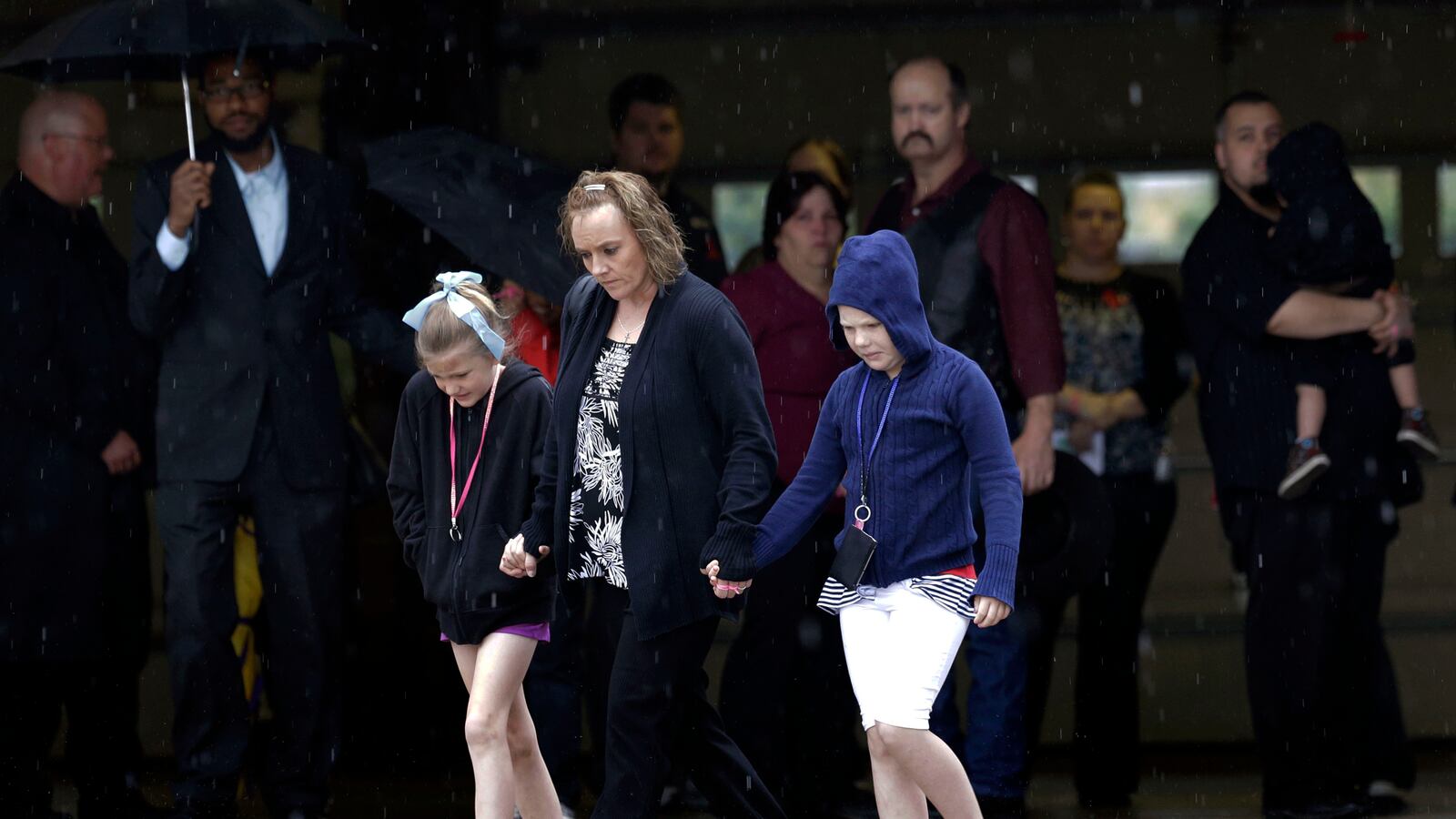A thunderstorm was sweeping through the Oklahoma City area, and the mourners had to travel through driving rain, hailstones, and flooded roads. They were going to the first funeral for the victims of the latest killer tornado.

Country music with a Christian theme was playing inside the South Colonial Chapel, where an easel held an enlarged photo of a smiling little girl in a pink-fringed bonnet. Nine year-old Antonia Lee Candelaria was known as “Tonie” or “Ladybug,” loved to paint and draw, and had just auditioned as a singer for an upcoming talent show.
“Tonie always danced, not walked,” her family had written.
Antonia died with six other students at the Plaza Towers Elementary School, including 9-year-old Emily Conatzer, who had been her very best friend from the instant they met on the first day of school.
Antonia’s mother, Brandie Candelaria, had seen some marks on her daughter’s forearm when she identified her body at the medical examiner’s office. She had afterward wondered aloud if perhaps somebody, maybe even Emily, had clutched Antonia during the final moments.
In the immediate aftermath of the twister, Antonia’s father, Jimmy, had managed to rescue her sister, Trinity, from the mass of bricks and cinderblocks and twisted steel. He had been unable to find Antonia before the first responders ordered all civilians away.
Emily’s sister, Luci, was also rescued. But Emily herself and her best friend Antonia were beyond saving when they were found in the rubble, which included the wreckage of a $1.5 million addition that had been approved by the town of Moore’s school board back in 2005.
The 11,000-square-foot addition had included eight new classrooms and a new computer lab as well as additional restrooms and storage—but no tornado shelter to make up for the absence of one when the school was built in 1966.
In the small Oklahoma town of Tushka, two hours away, the public school has a pair of shelters: one century-old and underground, the other an aboveground reinforced structure adjacent to the pre-school.The shelters most recently proved their value two years ago, when the school took a direct hit from a tornado.
“Three hundred children were saved that day,” says Janet Barresi, the state superintendent of public instruction.
The lack of a shelter at Plaza Towers and too many other schools in Tornado Alley is all the more startling because the Oklahoma City area is otherwise so well prepared for twisters. The National Weather Service in Norman has what are widely recognized as the best meteorologists around. And paramedics such as those of the Emergency Medical Service Authority drive their ambulances right behind a tornado so as to be able to help whomever is in need during the first critical minutes after the storm has done its worst. The big twister on Monday had no sooner moved on than the paramedics were there.
“We had crews coming in while there were still papers and debris falling from the sky,” says Col. Tom McCarty, an EMSA supervisor.
McCarty himself was following the tornado so closely that the hood of his vehicle was dented by the storm’s hail. He allows that he could not help but see a kind of beauty in nature at her most intensely destructive.
“It’s strange to say, they’re beautiful in how awesome they are,” he says of twisters seen up close, emphasizing that he does not for a moment forget how deadly and destructive they are. “But the sight of them, they’re awe-inspiring.”
The beauty of humans at their best commenced as dozens of ambulances parked in intersections, making themselves prominently visible in the still-clearing air to anybody who needed help but was unable to call 911 with the phones all suddenly out.
“People will come to an ambulance,” McCarty said.
If someone needed to be extricated from the rubble, the paramedics summoned firefighters, who were also already on the scene. The seriously injured adults were immediately transported to the trauma center at the Oklahoma University Medical Center. Kids were taken to the pediatric trauma team at the affiliated Children’s Hospital.
The chief of pediatric surgery there, Dr. Robert Letton, had served in the Army Reserve. He feared that the ambulances from the twister’s swath would bring carnage such as he had seen in our most recent war. He could have almost been back at a military hospital awaiting incoming combat casualties.
“I had flashbacks of being over there and 10 Marines all of a sudden being brought in,” Letton says.
But of the 59 children who arrived at the center only two were in such critical condition that they needed immediate surgery. And even these suffered treatable exterior fractures of the lower extremities, not the head injuries seen after the last monster twister in 1999.
“What kills them is the head injury,” Letton says. The other injuries from this latest twister largely seemed to come from flying debris. “Shrapnel wounds,” Letton says.
He noted that some wounds were on the arms and looked like they might have been suffered while covering the head, as children in Oklahoma are now taught to do. He found new reason to praise a campaign that emphasized protecting the head, even advising parents to put bicycle helmets on their kids if they did not have an actual tornado shelter.
“If they can’t build a shelter maybe the best thing to do is have a big bag of bicycle helmets,” Letton says.
Even helmets would not likely have saved the seven kids at the Plaza Towers School, who had been taught to cover their heads in drill after drill, but could do nothing about the weight of the rubble. It was so crushing that they were unable to breathe and the medical examiner listed the cause of death for six of them as “mechanical asphyxia.” The seventh child was said to have died from “blunt force trauma,” though apparently not of the head.
A 4-year-old as well two babies, four and seven months, had died in locations other than the school. Fourteen adults had also perished. But to look at the 17-mile long, mile-wide path of near total destruction is to wonder why many more people of all ages were not killed.
“I think it’s awareness,” Letton says.
He meant that Oklahomans have gotten ever better at living with tornadoes. He himself has built a shelter in his garage that has a sliding steel door and a transmitter whose signal is registered with FEMA to give his location if he and his family end up trapped under rubble.
But there was no shelter at the Plaza Towers school. Antonia’s mother has said that now is not the time for finger pointing, but it's hard to imagine any explanation beyond the fiscal for not having what Tushka has had for a century. The thought that it was all about funding added poignancy to a classroom poster that lay in the ruins of the school.
“A penny’s worth one.A nickel’s worth five.A dime’s worth ten.And a quarter 25Hey…honey bunnyI know… my money, money!”
Near that was another poster marked “read-a-rhyme” and featuring Humpty Dumpty. The ending of a nursery rhyme every youngster knows turned wrenching in the rubble where seven kids had died.
“All the king’s horse and all the king’s menCouldn’t put Humpty together again.”
As dawn neared, lightning flashes illuminated the darkened ruins and the surrounding streets. Thunder rumbled across the area as if to rouse the mourners from their beds or wherever those made homeless by the twister were able to sleep.
The rains brought floods, and then hail added to what made just getting to the funeral a challenge. But come they did, some stepping in dress shoes through a street turned into a small muddy river. Those in attendance included 6-year-old Kaden Shippers, who arrived in a red Plaza Towers T-shirt, staples closing a scalp wound and stitches in his back, but manifestly alive, able to feel his father’s touch on his head.
By one account, Antonia and her best friend, Emily, had been found still holding hands. Deacon Marti Gulikers spoke of a bond that would continue beyond death.
“They followed each other into heaven,” he said. “They will never be alone.”
Outside, the rain abated. And soon the sky began to clear into the kind of day that seems made for kids when we live up to our duty to keep them safe.





